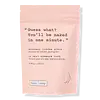What's inside
What's inside
 Key Ingredients
Key Ingredients

 Benefits
Benefits

 Concerns
Concerns

 Ingredients Side-by-side
Ingredients Side-by-side

Glycine Soja Oil
EmollientSucrose
HumectantButyrospermum Parkii Butter
Skin ConditioningCocos Nucifera Oil
MaskingHydrogenated Vegetable Oil
EmollientSilica
AbrasiveArgania Spinosa Kernel Oil
EmollientCitric Acid
BufferingAloe Barbadensis Leaf Extract
EmollientAnthemis Nobilis Flower Extract
MaskingSimmondsia Chinensis Seed Oil
EmollientLimnanthes Alba Seed Oil
Skin ConditioningPanax Ginseng Root Extract
EmollientCucumis Sativus Fruit Extract
EmollientBorago Officinalis Seed Oil
EmollientGlycerin
HumectantWater
Skin ConditioningCaprylyl/Capryl Glucoside
CleansingCaprylyl Glyceryl Ether
CleansingTocopherol
AntioxidantGlycolipids
Skin ConditioningSodium Cocoyl Glutamate
CleansingOlive Oil Polyglyceryl-6 Esters
EmollientAscorbyl Palmitate
AntioxidantGlycine Soja Oil, Sucrose, Butyrospermum Parkii Butter, Cocos Nucifera Oil, Hydrogenated Vegetable Oil, Silica, Argania Spinosa Kernel Oil, Citric Acid, Aloe Barbadensis Leaf Extract, Anthemis Nobilis Flower Extract, Simmondsia Chinensis Seed Oil, Limnanthes Alba Seed Oil, Panax Ginseng Root Extract, Cucumis Sativus Fruit Extract, Borago Officinalis Seed Oil, Glycerin, Water, Caprylyl/Capryl Glucoside, Caprylyl Glyceryl Ether, Tocopherol, Glycolipids, Sodium Cocoyl Glutamate, Olive Oil Polyglyceryl-6 Esters, Ascorbyl Palmitate
 Reviews
Reviews

Ingredients Explained
These ingredients are found in both products.
Ingredients higher up in an ingredient list are typically present in a larger amount.
Glycine Soja Oil comes from the soybean. Glycine Soja is native to eastern Asia.
Soybean oil is an emollient. It is rich in antioxidants and fatty acids including palmitic, stearic, oleic, and linoleic acids.
As an emollient, the fatty acids in soybean oil helps keep your skin soft and hydrated. It does so by creating a film on top that traps moisture in.
Soybean oil is also rich in vitamin E, a potent antioxidant. Vitamin E is also anti-inflammatory and provides a soothing effect.
Studies show soy may help fade hyperpigmentation from UVB. It does so by disrupting the melanin process from UVB induced skin inflammation.
This ingredient may not be malassezia folliculitis, or fungal-acne, safe.
Soybeans are rich in proteins and are part of the legume family. Foods made with soybeans include tofu, soymilk, edamame, miso, and soy sauce.
Learn more about Glycine Soja OilSucrose is a natural sugar found in fruits, vegetables, and nuts. It is the main constituent of white sugar.
In skincare, sucrose is a humectant and can be a mild exfoliant.
Sucrose is hydrophilic, meaning it attracts water. This makes it an effective humectant and helps hydrate the skin.
Studies show sugars may worsen acne-prone skin due to it disrupting the skin's natural biome. We recommend speaking with a professional if you have any concerns.
In some products such as body scrubs, sucrose is used as an gentle exfoliant.
The term 'sucrose' comes from the french word for sugar, 'sucre'.
Learn more about SucroseTocopherol (also known as Vitamin E) is a common antioxidant used to help protect the skin from free-radicals and strengthen the skin barrier. It's also fat soluble - this means our skin is great at absorbing it.
Vitamin E also helps keep your natural skin lipids healthy. Your lipid skin barrier naturally consists of lipids, ceramides, and fatty acids. Vitamin E offers extra protection for your skin’s lipid barrier, keeping your skin healthy and nourished.
Another benefit is a bit of UV protection. Vitamin E helps reduce the damage caused by UVB rays. (It should not replace your sunscreen). Combining it with Vitamin C can decrease sunburned cells and hyperpigmentation after UV exposure.
You might have noticed Vitamin E + C often paired together. This is because it is great at stabilizing Vitamin C. Using the two together helps increase the effectiveness of both ingredients.
There are often claims that Vitamin E can reduce/prevent scarring, but these claims haven't been confirmed by scientific research.
Learn more about TocopherolWater. It's the most common cosmetic ingredient of all. You'll usually see it at the top of ingredient lists, meaning that it makes up the largest part of the product.
So why is it so popular? Water most often acts as a solvent - this means that it helps dissolve other ingredients into the formulation.
You'll also recognize water as that liquid we all need to stay alive. If you see this, drink a glass of water. Stay hydrated!
Learn more about Water